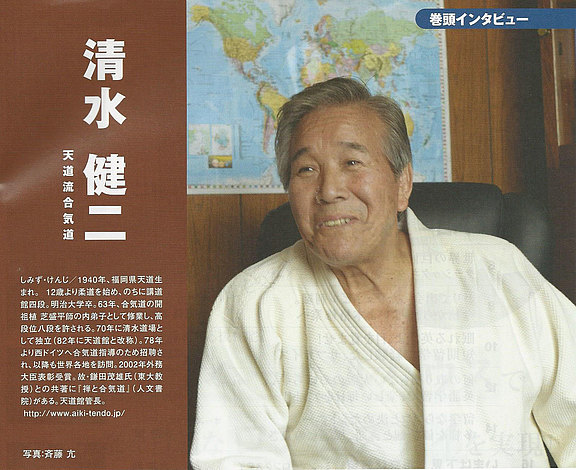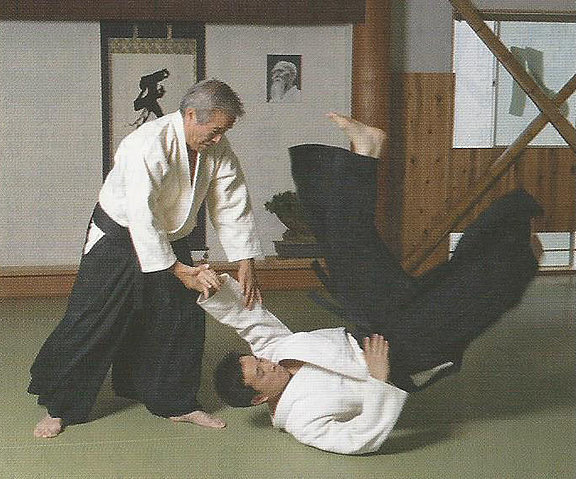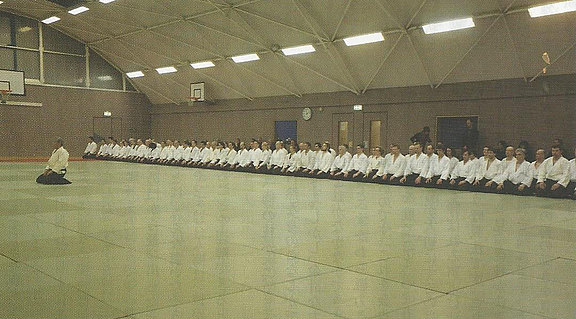Shimizu Kenji - Tendoryu Aikido
Translation of the interview with Shimizu Sensei in the October issue of the Japanese travel magazine ‚Longstay‘
Shimizu Kenji, born 1940 in the town Tento in the prefecture Fukuoka. At the age of 12 years start of Judo training at the Kodokan until 4th dan. Graduated at the Meiji University. Since 1963 training as Uchi-Deshi under the founder of Aikido, Master Morihei Ueshiba, obtaining the highly ranked 8th dan. In 1970 independence of the Shimizu Dojo (in 1982 renamed to Tendokan). Since 1978 invitations for Aikido seminars in West-Germany, thereafter as well visits to various places worldwide. In 2002 awarding of a prize by the Japanese Foreign Ministry. Co-author of the book ‘Zen to Aikido’ (publishing house Jimbun-Shoin) together with the late professor Shigeo Kamata (Tokyo University). Head of Tendokan.
‘For a master there is no form’ – that is the spirit of Aikido
I want to send the Budo spirit all over the world
Meeting with the master
About 50 years ago I started with Aikido. Back then a friend asked me the following: “There is someone, who is called the last Budoka. He has already reached an advanced age; therefore you should certainly begin an apprenticeship with him, and I would like you to adopt his techniques.” As I learned this was a man, who by all means was especially respected by the founder of Judo, Jigoro Kano Sensei. I was not able to persuade my mother, who resisted to this idea, but I did not give up and followed my friend, who wanted to introduce me.
This teacher, with whom I wanted to start my apprenticeship, was the founder of Aikido, Morihei Ueshiba Sensei (in the following called O-Sensei), who was called the last Budoka. At that time I was 23 years old. In those days I frequently did Ukemi for O-Sensei and for many other Sensei, as this was my job. By performing Ukemi in Aikido the body becomes flexible, you learn the right timing when doing the techniques – in short the ‘Kokyuu’ – and you train the ‘reading of the partner’, which is the most important issue in Budo. This fills all your techniques with life.
Thanks to the training and the intensive contact to O-Sensei I received the 4th dan exceptionally fast after 4 years. Thereafter I was teaching at companies and universities, even if I did not had much experience. Mr. Sonao Sonoda (minister of foreign affairs and later chief cabinet secretary), who at those days visited the Dojo very enthusiastically, established a special Aikido group at the parliament. I was asked to be the first teacher there. So I taught the members of parliament, the secretaries, as well as the reporter from television and newspaper, and after 3 years because of O-Sensei’s death, I became independent.
There is no competition in Aikido
An immediate reply on the question of the definition of Aikido is difficult; main difference to other Budo sports like Judo or Kendo and in general to common sports is that it is not carrying out contests. Every day solely the repetition of techniques. There is no competing to win prizes; it is a practice to control oneself. O-Sensei always taught us: “Physical strength is limited, Ki power is infinite. Let us develop the power of Ki. Let us try to do the techniques with the feeling to take in the whole earth.” By this he simultaneously scolded and encouraged us.
If contest is in the focus of interest, contest will be the objective during daily practice, but if training is in the focus of interest, it becomes training – contrarily to competition sports –, in which we do not want to defeat an opponent, but in which we overcome The Self, which does not want to be defeated. We get out of breath and we lose interest in practice, and frequently we give up, but if we continue with practice we will realize that our self becomes considerably stronger. By repeating the form over and over again, a technique will develop, from which the form imperceptible sneaks away, and free movements will be born. That is the reason why Aikido also is called ‘Moving Zen’. Furthermore, don’t we want to communicate to the rest of the world the mental state ‘that for a master there is no form any more’?
Hard, soft …. Although there are more or less physical differences, if we practice continuously, everybody is able to mature as a human being – and this we call living Aikido. This is an interesting aspect of Aikido, and that is the reason that women and older people, who have physically less strength, are able to practice Aikido carefree and cheerfully as well.
With other words, Aikido is Budo, in which we develop our abilities together. For example, if in Judo the opponent loses balance he will be thrown to the floor with all power, won’t he? In Aikido there are throwing techniques (nage waza), lever techniques (kime waza) and holding techniques (osae waza), but the opponent will not be thrown to the ground with all one’s strength as in Judo. By movements the opponent’s balance will be broken until the very moment of his fall, but those throwing techniques do not injure the opponent. This is not necessary as a body, which once is out of balance, cannot be controlled again.
Another characteristic is that the Dojo is a place, where everybody from a child until a senior and with no distinction of sex can chum up with Aikido. When I met O-Sensei for the first time, he was already 79 years old, and never before I had seen someone, who with this age was able to move so vigorously and intensively demonstrating Ki power in perfection. O-Sensei seemed to be a unique character almost like a hermit – hardly to find in nowadays world, and we had the impression that he had descended down to us from a different transcendent world. When he wanted to retired slowly, we were told that he didn’t want to admit Uchi Deshis anymore, and I learnt as a last Uchi Deshi three years directly by O-Sensei during my six years enrollment. It could well be said that ‘I was highly favored by O-Sensei’.
The wonderful techniques of Ono
One day O-Sensei asked me in front of many students including present cabinet ministers while pointing at me with a finger: “Aikido means the wonderful techniques of Odo. Do you understand?” Although later asking older students I could not yet understand those words. From which century those words may have come, or whether O-Sensei might have invented them, we were not able to understand the meaning entirely. As O-Sensei did not answer this question later, it remained in our minds all over the following years. Whatever the meaning was, we were thankful, and later we understood that the ‘wonderful techniques of Odo’ meant that although somebody is little or weak he nevertheless is able to demonstrate a great strength. That means that we may obtain a strong spirit, if we build one body with the whole universe.
There was the Russian amateur wrestler named Alexander Karelin, who won Olympic gold for three times and is considered as strongest man in the world. When he visited Japan after his retirement, a reporter asked him: “What is the secret of your strength?” It is said that he answered: “It is the flexibility/softness”. Certainly everybody was surprised to hear these unexpected words out of the mouth of a man, who was considered extremely strong, but people, who practice Budo, are able to understand his answer. If the wind blows the branches of a willow will bend, won’t they? Adapting this behavior with our own body is ideal. But that is not so easy, if superstitious strength is involved. Leaving behind physical strength or letting the strength flow off you is really most difficult. A key towards this understanding is breath technique. With other words, it is the breath control. We think that abdominal breathing is especially important, that is breathing control using the so called Tanden (point below the navel), which is located at the lower abdomen and which we feel as center of our body. We move our body in a way that the Tanden becomes the center of the movement. Magnificent techniques will be settled, and the Hakama draws an elegant bow. Watching the movement of the Hakama, we easily recognized whether somebody is skillful or not.
By the way, Mr. Hiroshi Arakawa, who coached the batting form (baseball) of Mr. Sadaharu Oh, was an Aikido expert, too, and he met me with great kindness. The batting form on one leg (‘flamingo stroke’) of a player has been improved step by step by Mr. Arakawa to take care of the timing, and this actually could be considered as ‘Aiki batting form’.
Winning without fighting
The characters 合気 (Aiki) mean ‘in harmony with the Ki’, that is literally reading the opponent’s Ki, and reading the Ki is important. Nowadays it has become difficult to construct a good human relationship between couples, parents and children, close friends, with your boss and with the colleagues. Somebody, who comes for practice to my place, told me: “In Aikido we do not need a language, don’t we? We are able to communicate with each other without using words. We repeat the techniques with a lively Ki, and I do understand how my partner moves.” I was full of admiration when he said that he stops conversation during practice. Periodically a blind student comes to the Dojo accompanied by his guide dog. Such a man is able to practice Aikido, too, and he says that he enjoys Aikido and that Aikido is excellent for him.
An essential point in Aikido is to win without fighting, to win without disputing. In some way fighting means losing. That means there is an opening. Sometimes in books on martial arts it is written that some people had a tremendous thirst for blood, but in our case it is quite different. If an opponent is afraid of us, it means that we did not yet practice enough. A true master will not give us the feeling of blood thirst; surely he will remain calmly with a friendly face. Because he has self-confidence there is no need to force the opponent.
International cultural exchange by Aikido
In 1978 there was a German, who specially asked my Dojo for help. His name was Volker Stenzel, who as far as I know was still a diplomat at that time. Until last year he lived in Japan and worked as ambassador. This man said: “By all means I want you to teach Aikido to the Germans.” He spoke fluent Japanese, due to his experience as a foreign student at the Kyoto University. That was fate, and I travelled to Germany to teach Aikido for the first time. Nowadays Aikido is wide spread to various places over Europe – with Germany as a center -, but the beginning is mainly due to the meeting with Volker Stenzel. Human relations are a wonderful thing, aren’t they? At that time I never had believed that Aikido would spread abroad in such a way. There is something else which is very different from our Aikido. I read in some report that worldwide there are about one million students in total. The students in my German Dojos are all practicing very enthusiastically.
In the first years people seemed to consider Aikido more as sport. Even during my explanations at seminars some participants used their elbows when sitting on the tatami, or in worst cases behaved even aggressive. During my seminars many times I pointed out that among other things 正座 (Seiza – sitting correctly in an upright position) is a basic posture, and thereafter this sitting posture became correctly, and today they nearly became exemplary in our eyes. Like this, there are always things as well which make a trainer happy.
For about three weeks each time we still travel abroad every year, in spring and in summer, to teach Aikido to the people. Among the various countries in Europe we spend most time in Germany. In the Black Forest (‘Schwarzwald’) the seminars take place at a state-owned training center, which is used by medalists, too. When intensively training for one and a half hour in the morning and one and a half hour in the afternoon, after one week some of the participants had lost so much weight that they could tighten their belts by two holes.
Regarding foreign students it strikes me most that career and Aikido have the same rank. In Japan people prioritize their career as a matter of course, foreign students on the contrary seem to work in order to live, and Aikido has become irreplaceable in their lives. Via Aikido life will be enriched with courage, endurance and emotional strength which in return support the movements of the body. We don’t do something special, but we develop a little the feeling of self-dedication, and we try to install a certain dignity to do good for other people spontaneously. That is the true objective of Aikido.
© Translated by Ichiro Murata and Dr. Peter Nawrot, Berlin 11/2014


